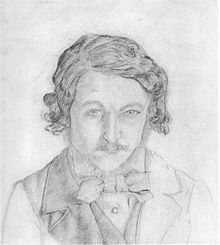“I was the master-mason of a church that was built more than six hundred years ago,” begins William Morris’s “Story of the Unknown Church”, his best piece of fiction from his Oxford years. Morris believed passionately in the continuity of history, in the past and its material and literary legacy as the root of art and life in the present—a form of real wealth on which civilization depends. This aspect of his thought is often misunderstood as merely sentimental and escapist “medievalism”. Morris, however, was deliberately not an escapist—although many of his cohorts had a hard time answering that charge. Indeed, he was very much engaged in his own day, and looked forward as well as back. And he regarded the arts of his day as gifts to endure, to inform and be enjoyed by posterity.

William Morris, self-portrait at age 22
The story (read it here) is a great example of his fondness for imaginative time travel, as well as his romanticism, which Morris simply equated with humanity. It’s an outpouring of human feeling, of the human spirit—an outpouring of love—for not only history but architecture and for his fellow human beings. In this case his beloved are the sister of the narrator and his sister’s husband, the narrator’s best friend. Their tragic end prompts the mason-narrator to carve them a tomb as well as a “marble canopy,” and to thus spend his final years making a frame for his memorial to these lovers whom he so loved—a great valentine.
The quote goes to the solace that art provides labor—a key Morrisian argument (actually he was in the first great flush of discovery of this idea in the work of John Ruskin) for restoring the arts to their rightful place in our daily work, including that of masons, and thereby redeeming and rescuing ordinary laborers from the miserable working conditions of industrializing England. In this, Morris was one of our greatest thinkers about the place of art; so even though he, unlike Rosetti, Burne-Jones and his other PreRaphaelite pals, didn’t have much to say about picture frames (reasons for this I could go into another time), he was in the greatest sense a framer of the whole matter of art. And in this case, his ideals are directly expressed in the story of the making of a frame.
But my main reason for drawing attention to “The Story of the Unknown Church” here is that it also goes to the role of the frame as praise and celebration—extending and sustaining the entire purpose of works of art, and keeping the cherished memories they embody close to us. As Ruskin said, “All true art is praise.”
Is Morris a bit over the top here? Yes, but he’s not the only one to overdo this nonetheless sound purpose of the frame (the other option is a frame made with indifference). And we can—especially on this day—forgive the passions of youth in the throes of discovery of the power of art and love!
So here’s a little valentine—sent many years ago—from William Morris, frame-maker.
« Back to BlogIt was just beneath the westernmost arch of the nave, there I carved their tomb: I was a long time carving it; I did not think I should be so long at first, and I said, “I shall die when I have finished carving it,” thinking that would be a very short time. But so it happened after I had carved those two whom I loved, lying with clasped hands like husband and wife above their tomb, that I could not yet leave carving it; and so that I might be near them I became a monk, and used to sit in the choir and sing, thinking of the time when we should all be together again. And as I had time I used to go to the westernmost arch of the nave and work at the tomb that was there under the great, sweeping arch; and in process of time I raised a marble canopy that reached quite up to the top of the arch, and I painted it too as fair as I could, and carved it all about with many flowers and histories, and in them I carved the faces of those I had known on earth (for I was not as one on earth now, but seemed quite away out of the world). And as I carved, sometimes the monks and other people too would come and gaze, and watch how the flowers grew; and sometimes too as they gazed, they would weep for pity, knowing how all had been. So my life passed, and I lived in that Abbey for twenty years after he died, till one morning, quite early, when they came into the church for matins, they found me lying dead, with my chisel in my hand, underneath the last lily of the tomb.